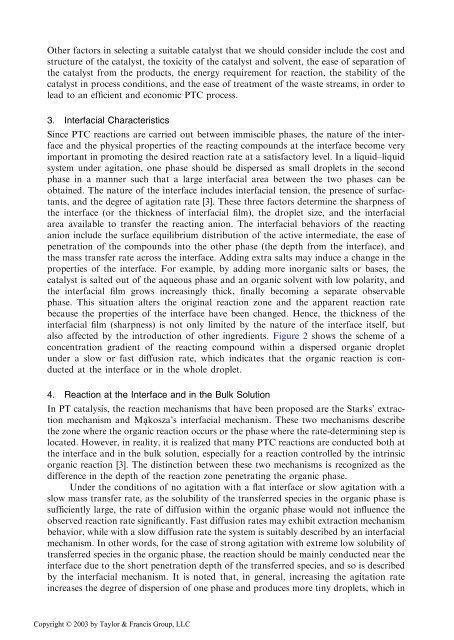11. Interfacial Mechanism and Kinetics of Phase-Transfer Catalysis
11. Interfacial Mechanism and Kinetics of Phase-Transfer Catalysis
11. Interfacial Mechanism and Kinetics of Phase-Transfer Catalysis
Create successful ePaper yourself
Turn your PDF publications into a flip-book with our unique Google optimized e-Paper software.
Other factors in selecting asuitable catalyst that we should consider include the cost <strong>and</strong>structure <strong>of</strong> the catalyst, the toxicity <strong>of</strong> the catalyst <strong>and</strong> solvent, the ease <strong>of</strong> separation <strong>of</strong>the catalyst from the products, the energy requirement for reaction, the stability <strong>of</strong> thecatalyst in process conditions, <strong>and</strong> the ease <strong>of</strong> treatment <strong>of</strong> the waste streams, in order tolead to an efficient <strong>and</strong> economic PTC process.3. <strong>Interfacial</strong> CharacteristicsSince PTC reactions are carried out between immiscible phases, the nature <strong>of</strong> the interface<strong>and</strong> the physical properties <strong>of</strong> the reacting compounds at the interface become veryimportant in promoting the desired reaction rate at asatisfactory level. In aliquid–liquidsystem under agitation, one phase should be dispersed as small droplets in the secondphase in amanner such that alarge interfacial area between the two phases can beobtained. The nature <strong>of</strong> the interface includes interfacial tension, the presence <strong>of</strong> surfactants,<strong>and</strong> the degree <strong>of</strong> agitation rate [3]. These three factors determine the sharpness <strong>of</strong>the interface (or the thickness <strong>of</strong> interfacial film), the droplet size, <strong>and</strong> the interfacialarea available to transfer the reacting anion. The interfacial behaviors <strong>of</strong> the reactinganion include the surface equilibrium distribution <strong>of</strong> the active intermediate, the ease <strong>of</strong>penetration <strong>of</strong> the compounds into the other phase (the depth from the interface), <strong>and</strong>the mass transfer rate across the interface. Adding extra salts may induce achange in theproperties <strong>of</strong> the interface. For example, by adding more inorganic salts or bases, thecatalyst is salted out <strong>of</strong> the aqueous phase <strong>and</strong> an organic solvent with low polarity, <strong>and</strong>the interfacial film grows increasingly thick, finally becoming a separate observablephase. This situation alters the original reaction zone <strong>and</strong> the apparent reaction ratebecause the properties <strong>of</strong> the interface have been changed. Hence, the thickness <strong>of</strong> theinterfacial film (sharpness) is not only limited by the nature <strong>of</strong> the interface itself, butalso affected by the introduction <strong>of</strong> other ingredients. Figure 2shows the scheme <strong>of</strong> aconcentration gradient <strong>of</strong> the reacting compound within a dispersed organic dropletunder a slow or fast diffusion rate, which indicates that the organic reaction is conductedat the interface or in the whole droplet.4. Reaction at the Interface <strong>and</strong> in the Bulk SolutionIn PT catalysis, the reaction mechanisms that have been proposed are the Starks’ extractionmechanism <strong>and</strong> Mąkosza’s interfacial mechanism. These two mechanisms describethe zone where the organic reaction occurs or the phase where the rate-determining step islocated. However, in reality, it is realized that many PTC reactions are conducted both atthe interface <strong>and</strong> in the bulk solution, especially for a reaction controlled by the intrinsicorganic reaction [3]. The distinction between these two mechanisms is recognized as thedifference in the depth <strong>of</strong> the reaction zone penetrating the organic phase.Under the conditions <strong>of</strong> no agitation with a flat interface or slow agitation with aslow mass transfer rate, as the solubility <strong>of</strong> the transferred species in the organic phase issufficiently large, the rate <strong>of</strong> diffusion within the organic phase would not influence theobserved reaction rate significantly. Fast diffusion rates may exhibit extraction mechanismbehavior, while with a slow diffusion rate the system is suitably described by an interfacialmechanism. In other words, for the case <strong>of</strong> strong agitation with extreme low solubility <strong>of</strong>transferred species in the organic phase, the reaction should be mainly conducted near theinterface due to the short penetration depth <strong>of</strong> the transferred species, <strong>and</strong> so is describedby the interfacial mechanism. It is noted that, in general, increasing the agitation rateincreases the degree <strong>of</strong> dispersion <strong>of</strong> one phase <strong>and</strong> produces more tiny droplets, which inCopyright © 2003 by Taylor & Francis Group, LLC
















